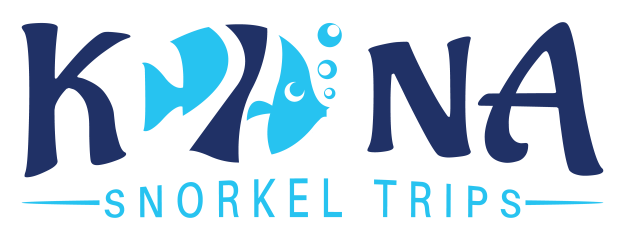Enchanting Manta Ray Kona Snorkel: Insider’s Adventure Guide
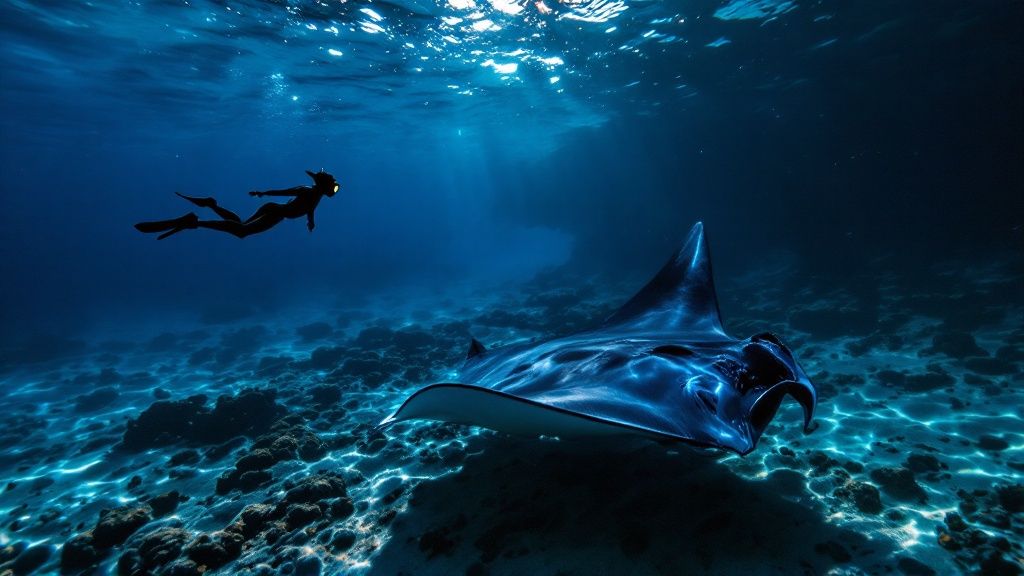
The Magic of Manta Ray Kona Snorkel Adventures
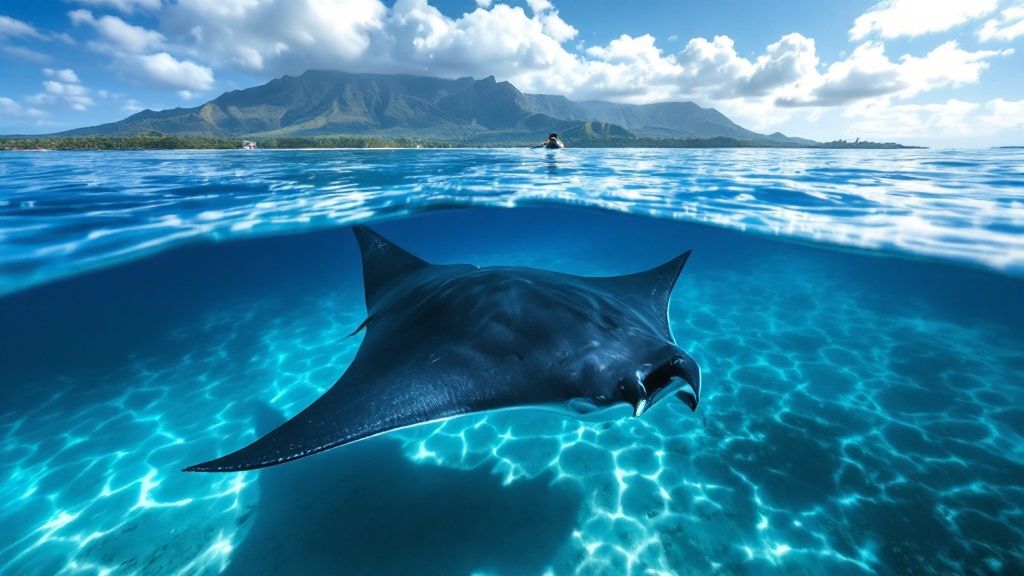
The Kona coastline offers an incredible opportunity to snorkel with manta rays. For a truly in-depth look at this experience, check out the Manta Ray Snorkel Kona Hawaii: The Ultimate Experience Guide. This area is known as one of the best places in the world to see these gentle giants, thanks to a unique combination of environmental factors.
Nutrient-rich currents attract large amounts of plankton, the manta rays' main food source. Calm, shallow waters in protected coves offer ideal viewing conditions. These factors help make Kona a top destination for manta ray encounters.
The nighttime viewing experience adds another layer of wonder. As darkness sets in, specialized lights attract plankton, bringing the manta rays closer to the surface. It’s a truly mesmerizing sight to watch these graceful creatures glide through the illuminated water. Some reef mantas have wingspans reaching 12-14 feet, while giant oceanic mantas can reach an impressive 22 feet. It's an experience often described as unforgettable.
Why Kona's Manta Ray Snorkeling Is So Special
The consistency of sightings in Kona contributes to its popularity. The Kona Coast boasts an impressive 80-90% sighting success rate year-round for manta ray snorkeling. Approximately 80,000 people participated in these tours in 2024. Popular spots like Manta Village and Manta Heaven use specialized lights to attract plankton, drawing in these magnificent creatures.
Between 2009 and 2014, researchers meticulously logged individual mantas, identifying them by their unique belly patterns. This allowed them to monitor the health and movements of the manta ray population. Monthly sightings ranged from 50-150 per site in 2013, a testament to Kona’s rich ecosystem. Since research began, over 290 individual rays have been cataloged, including Lefty, the first recorded manta in the area. More detailed statistics are available at Manta Ray Advocates.
The magic of the manta ray Kona snorkel comes down to several key elements. The high likelihood of sightings, the unique nighttime viewing conditions, and the sheer size and grace of these creatures create an unforgettable experience. It’s consistently ranked among Hawaii’s best wildlife adventures. Whether you're an experienced snorkeler or a beginner, this encounter promises a unique opportunity to connect with the wonders of the ocean and create lasting memories.
Prime Manta Ray Kona Snorkel Locations Revealed
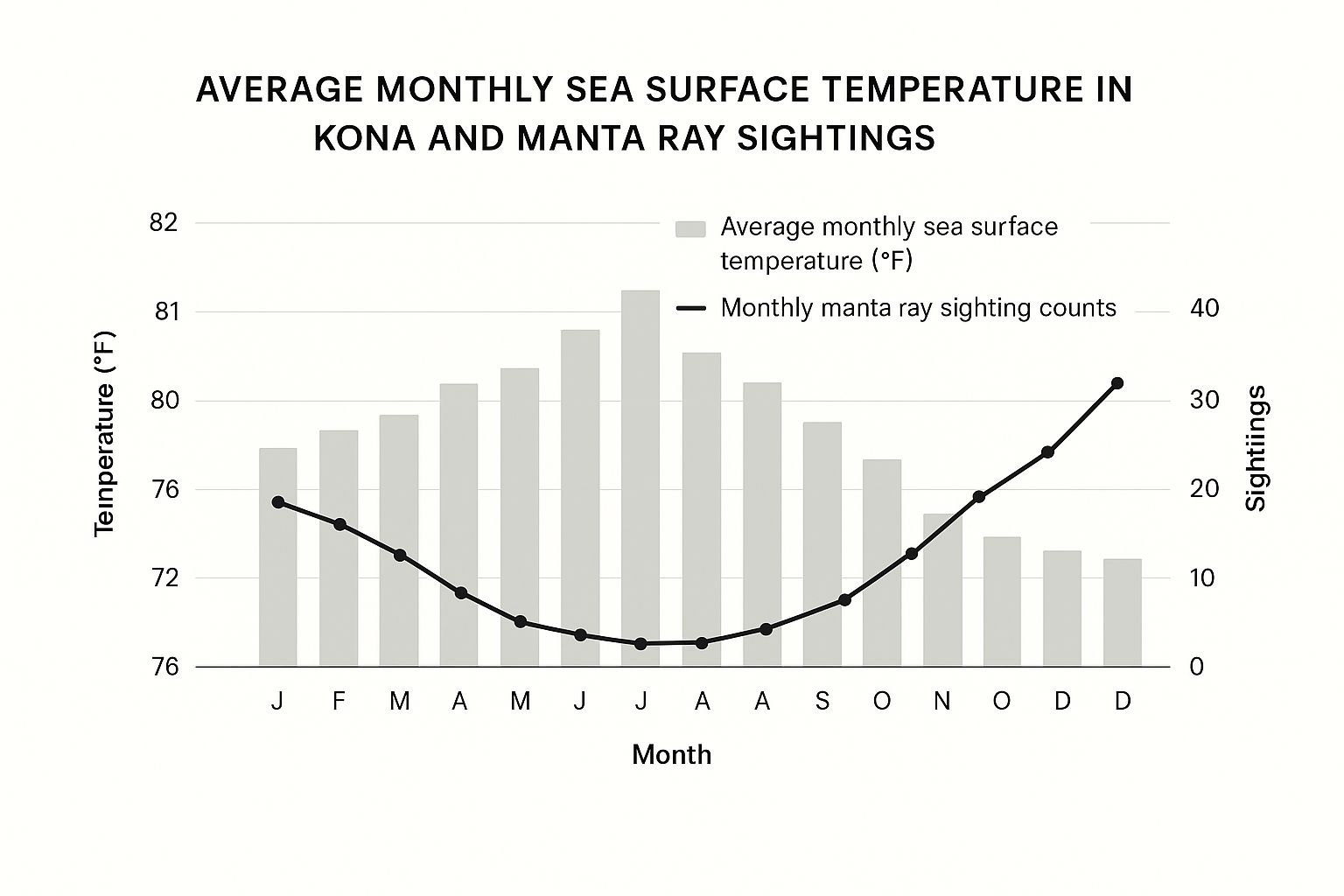
The data chart above compares the average manta ray sightings and typical depths at the two main Kona snorkel sites.
Kona, Hawaii, boasts two incredible locations for manta ray snorkel adventures: Manta Village (Garden Eel Cove) and Manta Heaven (Keauhou Bay). Each site offers a distinct experience, so choosing wisely can truly elevate your encounter with these majestic creatures. For more Kona activity information, check out this helpful resource: Our sitemap with more information on activities.
Manta Village (Garden Eel Cove)
Manta Village lives up to its name, consistently attracting these gentle giants. The relatively shallow depth, typically between 30-40 feet, makes this site perfect for snorkelers of all levels. This area became a popular feeding ground thanks to nearby resorts shining lights into the water, attracting plankton, the manta rays' primary food source.
Manta Heaven (Keauhou Bay)
Manta Heaven, nestled in Keauhou Bay, presents a slightly different ambiance. Known for its calmer waters, it's a great option for those susceptible to seasickness. Like Manta Village, this area also became a manta ray hotspot due to resort lighting attracting plankton. The depth here varies from 20 to 50 feet, averaging around 35 feet, making it suitable for a wide range of snorkelers.
Choosing Your Ideal Location
Deciding which location suits you best depends on your personal preferences and experience. Manta Heaven is often recommended for beginners or those preferring calmer conditions. More experienced snorkelers seeking potentially larger groups of manta rays might prefer Manta Village. Consider your comfort level in the water and desired activity level when making your choice. Captain Cook Snorkeling Tours offer excursions to both locations. For a comprehensive look at available tours, visit Kona Snorkel Trips.
To help you choose the right spot, we've compiled a comparison table highlighting the key features of each location:
Kona Manta Ray Snorkel Sites Comparison: Comparison of the main manta ray snorkel locations in Kona, highlighting key differences to help you choose the best site for your experience
| Site Name | Location | Best For | Typical Depth | Average Manta Sightings | Special Features |
|---|---|---|---|---|---|
| Manta Village | Garden Eel Cove | All skill levels | 30-40 feet | 10-15 | Consistent manta presence |
| Manta Heaven | Keauhou Bay | Beginners, calm conditions | 20-50 feet | 5-10 | Calmer waters, suitable for seasickness-prone individuals |
As the table shows, Manta Village typically has more manta ray sightings while Manta Heaven boasts calmer waters. Remember, actual sightings can vary based on environmental factors like currents, plankton availability, and moon phases. As seen in the data chart, Manta Village typically sees 10-15 manta rays while Manta Heaven averages 5-10. No matter which location you choose, a manta ray snorkel in Kona guarantees an unforgettable adventure.
Essential Preparation for Manta Ray Kona Snorkel Success
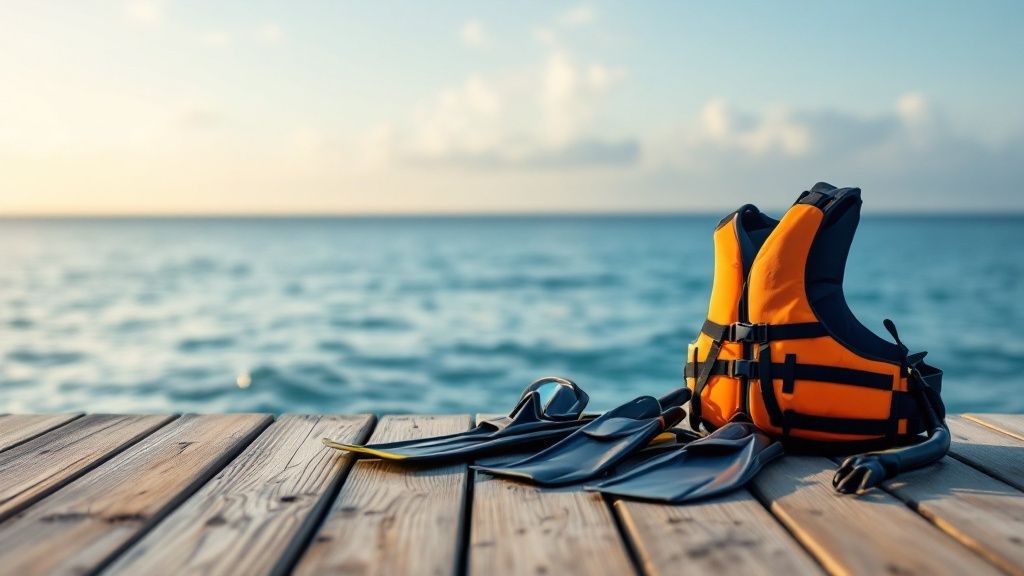
Getting ready for a manta ray snorkel trip in Kona involves more than just grabbing your swimwear. Proper planning ensures a comfortable and memorable adventure, from selecting the right gear to addressing potential seasickness.
Gear Up For Success
Evening water temperatures can dip, making a wetsuit crucial. A 3mm or 5mm wetsuit usually provides sufficient warmth. If you're prone to feeling cold, consider a thicker one or layering. Many tour operators provide wetsuits, so check with yours beforehand.
Besides a wetsuit, remember a few often-forgotten essentials. A small, waterproof flashlight helps navigate the boat deck after sunset. Anti-fog solution keeps your mask clear for optimal underwater viewing. And a reusable water bottle keeps you hydrated while minimizing your environmental footprint. You might be interested in: Our sitemap with helpful pages.
Physical and Mental Readiness
If you aren't a frequent swimmer, boosting your water confidence before your trip enhances your experience. Practice using your snorkel gear and get comfortable floating in a pool or calm ocean waters. Kona's manta ray snorkel tours have become a model for global ecotourism. Two species—reef mantas (12-14 feet wingspans) and giant oceanic mantas (up to 22 feet) —frequent the area.
Data from 2024 showed 80,000 annual participants, highlighting the tours' economic impact. Long-term tracking since 2009 reveals stable manta ray populations despite tourism. Historical data since 2013 confirms monthly sightings of 50-150 mantas at key locations, sustained by plankton-rich ocean currents. Discover more insights about manta rays in Hawaii.
Motion sickness can sometimes affect boat trips. Over-the-counter medication or acupressure wristbands can help. Selecting a tour with a stable boat and an experienced captain also contributes to a smoother ride. When planning, consider adding a visit to Oahu to your itinerary. Check out the things to see and do in Honolulu.
Embracing the Night
Night snorkeling differs significantly from daytime swims. Mentally preparing for the dark can ease any concerns. Remember, you'll be with a guide and a group. Lights attract plankton, creating a localized area of visibility. The experience is genuinely magical, worth overcoming any initial hesitation. Keep these tips in mind and prepare to be amazed by the wonders of the manta ray Kona snorkel.
Selecting Your Perfect Manta Ray Kona Snorkel Tour
With so many manta ray snorkel tours in Kona, finding the perfect one can be a challenge. This guide will help you book your tour with confidence, ensuring an unforgettable experience. We'll explore the key factors that set tours apart and offer insights into different operators.
Key Considerations When Choosing a Tour
Several elements contribute to a truly memorable manta ray snorkel adventure. Group size plays a major role in your overall viewing enjoyment. Smaller groups offer a more personalized experience with the guides, and it's less crowded around the manta rays. This leads to increased safety and unobstructed views of these magnificent creatures.
Expert guides are essential. Their knowledge enhances your experience, providing information about manta ray behavior, the local ecosystem, and ocean conditions. Look for guides who are passionate about marine life and committed to responsible ecotourism.
Boat comfort matters too. A stable vessel with plenty of space to sit and move around makes the trip more enjoyable, especially in rough seas. Some boats even include amenities like restrooms, changing areas, and freshwater showers, enhancing your comfort.
Finally, consider the tour's educational aspects. Some operators emphasize conservation and education, sharing information about manta ray research and the importance of habitat preservation. This adds a valuable dimension to the tour, fostering a deeper appreciation for the marine environment.
Comparing Kona Manta Ray Tour Operators
To simplify your decision-making process, we've created a comparison table showcasing reputable tour operators in Kona. This table provides a detailed overview of group sizes, durations, inclusions, pricing, and special features, allowing you to easily compare your options.
Kona Manta Ray Tour Comparison: Detailed comparison of top-rated manta ray snorkel tour operators in Kona to help you choose the right experience for your needs
| Tour Operator | Group Size | Duration | Inclusions | Price Range | Special Features | Booking Link |
|---|---|---|---|---|---|---|
| Kona Honu Divers | Small | 2-3 hours | Wetsuit, snorkel gear, snacks, drinks | $$ | Experienced guides, focus on small groups | Book Now |
| Manta Ray Night Snorkel Hawaii | Medium | 2-3 hours | Wetsuit, snorkel gear, hot chocolate, cookies | $$ | Hot showers onboard, underwater photography assistance | Book Now |
| Kona Snorkel Trips | Small | 2-3 hours | Wetsuit, snorkel gear, reef-safe sunscreen | $$ | Eco-conscious practices, knowledgeable staff | Book Now |
| Captain Cook Snorkeling Tours | Medium | 2-3 hours | Wetsuit, snorkel gear, snacks, drinks | $$ | Offers tours to various locations, including Kealakekua Bay | Book Now |
This table allows you to quickly compare key features and find the tour that best suits your preferences. Whether you prioritize small groups, specific inclusions, or special features, this information will help you narrow down your choices.
Questions to Ask Before Booking
Before booking, asking a few questions will help you choose the right tour for you. Inquire about safety protocols, including emergency procedures and the guide-to-guest ratio. Check if they have a certified lifeguard on board. Also, ask about the type of vessel and its amenities. Make sure you understand what's included in the price, like equipment rental, snacks, and drinks. Finally, understand their cancellation policy in case your plans change.
By considering these factors and asking the right questions, you can select a manta ray snorkel tour in Kona that will not only meet but exceed your expectations. Whether you prefer a smaller, more personal adventure or a fun, family-friendly experience, careful planning will make your manta ray encounter truly special.
The Manta Ray Kona Snorkel Experience Unveiled
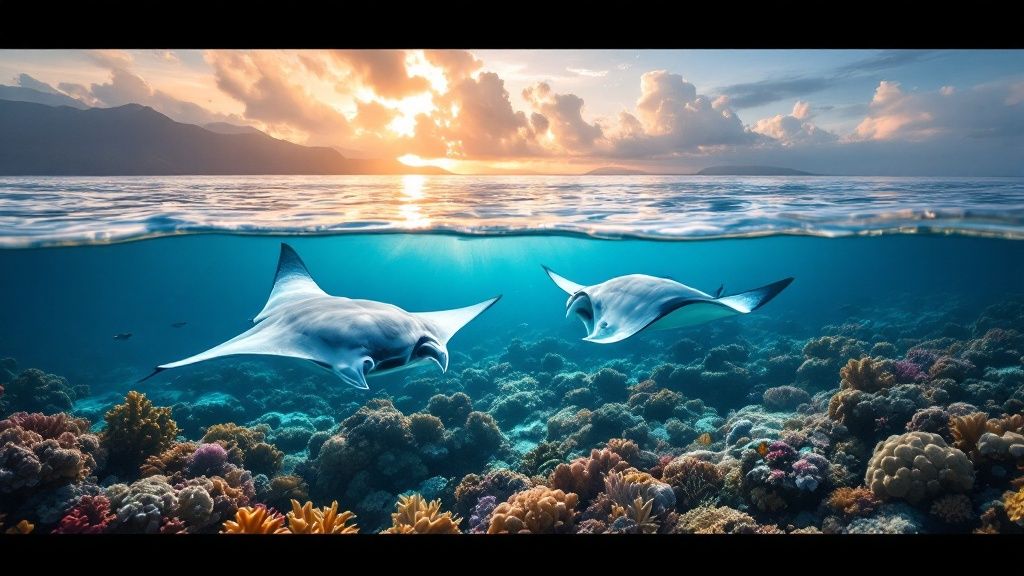
Let's explore what a typical manta ray Kona snorkel experience is like, from the boat ride to the incredible underwater encounter. This section details everything you can expect on this amazing adventure.
Setting The Stage: The Boat Ride and Briefing
Your adventure starts with a boat trip to the snorkel site, either Manta Village or Manta Heaven. Knowledgeable guides share interesting information about manta rays and the local environment, building excitement for the encounter ahead.
They'll also cover important safety procedures and demonstrate how to use your snorkel gear correctly. This preparation ensures you're comfortable and ready for the experience.
The Snorkel Platform: Your Gateway To The Underwater World
Once you arrive, the crew deploys a special snorkel platform with bright lights. These attract plankton, the manta rays' main food source, bringing them closer to the surface. The platform offers a safe and stable viewing area.
It's designed with handholds so you can stay in place while observing the mantas from a respectful distance. This allows for an immersive experience without disturbing the natural behaviors of these gentle giants.
The Manta Ballet Begins: An Underwater Spectacle
As plankton gathers in the illuminated water, the manta rays appear, sometimes like huge shadows gracefully emerging from the deep. They perform captivating underwater acrobatics, often surprisingly close to the surface and the snorkelers.
Their movements are truly mesmerizing. Watch as they execute barrel rolls and backflips, their enormous mouths open wide to filter the plankton. It's a rare opportunity to witness their feeding habits and unique behaviors up close.
A Close Encounter: How Near Do They Come?
One of the most exciting parts of the Kona snorkel is how close these gentle giants come. They often swim within just a few feet, sometimes even brushing against you. Remember, these are wild animals.
Touching them is discouraged. Guides emphasize responsible viewing to protect both the snorkelers and the manta rays. Kona Snorkel Trips prioritizes the wellbeing of everyone involved.
Water Conditions and Visibility: What To Expect
Water conditions and visibility depend on factors like currents and weather. Kona typically has excellent visibility, but nighttime conditions present specific challenges. The platform lights enhance visibility in a localized area.
This allows you to clearly observe the manta rays feeding and moving through the water. Guides are skilled at selecting locations with ideal water clarity and minimal currents, ensuring the best possible viewing experience. Captain Cook Snorkeling Tours are also known for their navigation expertise in these waters.
Moments of Wonder: Lasting Impressions
The manta ray Kona snorkel is more than an activity; it's a chance to connect deeply with nature. Seeing these magnificent creatures in their natural habitat is an inspiring experience, often described as life-changing.
The memory of these graceful giants dancing beneath the waves will stay with you long after you leave, a testament to the beauty and wonder of the ocean. It's an experience that truly resonates with the soul.
Preserving Your Manta Ray Kona Snorkel Memories
Experiencing a manta ray snorkel in Kona is truly magical. But how do you capture that awe and keep the memories alive long after you've dried off? This section offers some tips for preserving the wonder, from underwater photography advice to choosing meaningful souvenirs.
Underwater Photography: Capturing the Moment
Photos and videos offer a tangible link to your manta ray adventure. However, nighttime underwater photography can be challenging. The low light and constant movement of the rays require some specific techniques and equipment.
-
Equipment Options: Smartphone housings provide an affordable way to capture underwater moments. For enhanced quality, a dedicated underwater camera is a worthwhile investment. Many professional underwater photographers who specialize in manta rays recommend particular cameras and housings, often with external strobes or lights for ideal illumination.
-
Camera Settings: Adjusting your camera settings is key to capturing clear images in the dark. A high ISO, wide aperture, and a fast shutter speed are essential for freezing the action and minimizing blur.
-
Positioning: Getting the perfect shot shouldn't come at the expense of the animals' well-being. Position yourself thoughtfully and avoid sudden movements that may disturb them. Experienced guides can help you get close enough for stunning photos while respecting the manta rays.
-
Post-Processing: A little post-processing can significantly improve your underwater photos. Software like Adobe Lightroom or GIMP allows you to fine-tune contrast, brightness, and sharpness, transforming your images into breathtaking mementos.
Beyond the Lens: Other Memorable Keepsakes
Photos aren't the only way to remember your snorkel trip. Journaling, for example, offers a personal and reflective space to document your feelings and observations.
-
Journaling Prompts:
- Describe the sensation of a manta ray gliding below you.
- What aspect of the experience surprised you the most?
- How did the encounter deepen your connection to the ocean?
Consider your souvenir choices, too. Instead of buying items that harm the environment or exploit marine life, opt for sustainable alternatives. Support local artisans, purchase recycled crafts, or donate to a manta ray conservation organization.
You can also contribute to ongoing research through citizen science projects. Submitting your photos for identification helps researchers track manta ray populations and movements. This is a meaningful way to give back and stay connected to your experience. Organizations like Manta Ray Advocates welcome this type of participation.
Make a Splash with Kona Snorkel Trips!
Ready to experience the magic of manta rays firsthand? Kona Snorkel Trips offers exceptional tours led by experienced guides who prioritize safety, education, and respect for the marine environment. Book your adventure today and create memories to last a lifetime!
